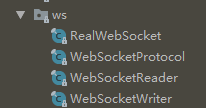Okhttp3源码分析之六
了解OKHTTP的都知道,它提供websocket的使用
声明OkHttp client
client = new OkHttpClient.Builder()
.readTimeout(3, TimeUnit.SECONDS)
.build();创建websocket
Request request = new Request.Builder()
.url(serverUrl)
.build();
webSocket = client.newWebSocket(request, new WebSocketListener()
***省略接下来分析一下OKHTTP的websocket
在OKHTTP中封装的websocket主要是这几个类
- WebSocketListener顾名思义就提供上层APP使用的回调
- webSocket 接口类,提供RealWebSocket实现
- WebSocketProtocol 协议
- WebSocketWriter&WebSocketReader就是对io流的读写
- RealWebSocket 真实实现WebSocket的类
RealWebSocket
那么websocket是怎么连接的?
public void connect(OkHttpClient client) {
client = client.newBuilder()
.eventListener(EventListener.NONE)
.protocols(ONLY_HTTP1)
.build();
final Request request = originalRequest.newBuilder()
.header("Upgrade", "websocket")
.header("Connection", "Upgrade")
.header("Sec-WebSocket-Key", key)
.header("Sec-WebSocket-Version", "13")
.build();
call = Internal.instance.newWebSocketCall(client, request);
call.timeout().clearTimeout();
call.enqueue(new Callback() {
@Override public void onResponse(Call call, Response response) {
try {
checkResponse(response);
} catch (ProtocolException e) {
failWebSocket(e, response);
closeQuietly(response);
return;
}
// 将http流提升为web套接字流
StreamAllocation streamAllocation = Internal.instance.streamAllocation(call);
streamAllocation.noNewStreams(); // Prevent connection pooling!
Streams streams = streamAllocation.connection().newWebSocketStreams(streamAllocation);
//处理websocket信息
try {
listener.onOpen(RealWebSocket.this, response);
String name = "OkHttp WebSocket " + request.url().redact();
//创建读写流
initReaderAndWriter(name, streams);
streamAllocation.connection().socket().setSoTimeout(0);
//循环读取数据
loopReader();
} catch (Exception e) {
failWebSocket(e, null);
}
}
@Override public void onFailure(Call call, IOException e) {
failWebSocket(e, null);
}
});
}初始化输入输出流
public void initReaderAndWriter(String name, Streams streams) throws IOException {
synchronized (this) {
this.streams = streams;
//写入流
this.writer = new WebSocketWriter(streams.client, streams.sink, random);
this.executor = new ScheduledThreadPoolExecutor(1, Util.threadFactory(name, false));
//处理心跳
if (pingIntervalMillis != 0) {
executor.scheduleAtFixedRate(
new PingRunnable(), pingIntervalMillis, pingIntervalMillis, MILLISECONDS);
}
//若队列非空,则发送数据
if (!messageAndCloseQueue.isEmpty()) {
runWriter(); // Send messages that were enqueued before we were connected.
}
}
//读取流
reader = new WebSocketReader(streams.client, streams.source, this);
}
//循环接收数据
public void loopReader() throws IOException {
while (receivedCloseCode == -1) {
// This method call results in one or more onRead* methods being called on this thread.
reader.processNextFrame();
}
}
pingRunnable心跳线程
private final class PingRunnable implements Runnable {
PingRunnable() {
}
@Override public void run() {
writePingFrame();
}
}
void writePingFrame() {
WebSocketWriter writer;
int failedPing;
synchronized (this) {
if (failed) return;
writer = this.writer;
failedPing = awaitingPong ? sentPingCount : -1;
sentPingCount++;
awaitingPong = true;
}
if (failedPing != -1) {
failWebSocket(new SocketTimeoutException("sent ping but didn't receive pong within "
+ pingIntervalMillis + "ms (after " + (failedPing - 1) + " successful ping/pongs)"),
null);
return;
}
try {
writer.writePing(ByteString.EMPTY);
} catch (IOException e) {
failWebSocket(e, null);
}
}
发送数据线程
循环获取队列数据,并发送
this.writerRunnable = new Runnable() {
@Override public void run() {
try {
while (writeOneFrame()) {
}
} catch (IOException e) {
failWebSocket(e, null);
}
}
};执行发送线程于线程池
private void runWriter() {
assert (Thread.holdsLock(this));
if (executor != null) {
executor.execute(writerRunnable);
}
}出列,并发送数据
boolean writeOneFrame() throws IOException {
WebSocketWriter writer;
ByteString pong;
Object messageOrClose = null;
int receivedCloseCode = -1;
String receivedCloseReason = null;
Streams streamsToClose = null;
synchronized (RealWebSocket.this) {
if (failed) {
return false; // Failed web socket.
}
//出列,发送数据
writer = this.writer;
pong = pongQueue.poll();
if (pong == null) {
messageOrClose = messageAndCloseQueue.poll();
if (messageOrClose instanceof Close) {
receivedCloseCode = this.receivedCloseCode;
receivedCloseReason = this.receivedCloseReason;
if (receivedCloseCode != -1) {
streamsToClose = this.streams;
this.streams = null;
this.executor.shutdown();
} else {
// When we request a graceful close also schedule a cancel of the websocket.
cancelFuture = executor.schedule(new CancelRunnable(),
((Close) messageOrClose).cancelAfterCloseMillis, MILLISECONDS);
}
} else if (messageOrClose == null) {
return false; // The queue is exhausted.
}
}
}
try {
if (pong != null) {
writer.writePong(pong);
} else if (messageOrClose instanceof Message) {
ByteString data = ((Message) messageOrClose).data;
BufferedSink sink = Okio.buffer(writer.newMessageSink(
((Message) messageOrClose).formatOpcode, data.size()));
sink.write(data);
sink.close();
synchronized (this) {
queueSize -= data.size();
}
} else if (messageOrClose instanceof Close) {
Close close = (Close) messageOrClose;
writer.writeClose(close.code, close.reason);
// We closed the writer: now both reader and writer are closed.
if (streamsToClose != null) {
listener.onClosed(this, receivedCloseCode, receivedCloseReason);
}
} else {
throw new AssertionError();
}
return true;
} finally {
closeQuietly(streamsToClose);
}
}总结:
webSocket创建一个http连接,然后将http流提升为web套接字流,然后不断从消息队列里发送数据,并不断读取接收到的数据,
调用WebSocketListener的一系列方法回调给上层APP

